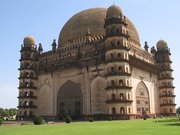Bijapur
|
|
Bijapur is a district in the Indian state of Karnataka. Bijapur City is the capital of the district and is located 530 km northwest of Bangalore.
| Contents |
History
The ancient name of Bijapur is Vijayapura (City of victory). It was established in the 10th-11th centuries by the Chalukyas of Kalyani. The city came under the influence of the Khilji Sultanate in Delhi by the late 13th century. In 1347, the area was conquered by the Bahmani Sultanate of Bidar.
In 1518, the Bahmani Sultanate split into five splinter states known as the Deccan sultanates, one of which was Bijapur, ruled by the kings of the Adil Shahi dynasty (1489-1686). The rule of this dynasty ended in 1686, when Bijapur was conquered by the Mughal emperor Aurangzeb. In 1724 the Nizam of Hyderabad established his independence in the Deccan, and included Bijapur within his dominions. In 1760, the Nizam suffered a defeat by the Marathas, and ceded the region of Bijapur to the Maratha Peshwa. After the 1818 defeat of the Peshwa by the British in the Third Anglo-Maratha War, Bijapur passed into the hands of the British East India Company, and was assigned to the princely state of Satara. In 1848 the territory of Satara, along with Bijapur, was annexed to Britain's Bombay Presidency when the last Maharaja died without a male heir.
Attractions
Bijapur is rich in historical attractions, mainly related to Islamic architecture.
- Gol Gumbaz: This is the most famous monument in Bijapur. It is the tomb of Mohammed Adil Shah (ruled 1627-1657). It is the second largest dome ever built, next in size only to St Peter's Basilica in Rome. A particular attraction in this monument is the central chamber, where every sound is echoed seven times. Another attraction at the Gol Gumbaz is the Whispering Gallery, where even minute sounds can be heard clearly 37 metres away.
- Ibrahim Rauza: This is the tomb of Ibrahim Adil Shah II (ruled 1580-1627), who was known for religious tolerance, like the Mughal emperor Akbar and was the fifth king of the dynasty. Built on a single rock bed, it is noted for the symmetry of its features. It is said that the design for the Ibrahim Rauza served as an inspiration for that of the famous Taj Mahal.
- Malik-e-Maidan (The Monarch of the Plains) the largest medieval cannon in the world. Being 4 m long, 1,5 m in diameter and weighing 55 tons, this gun was brought back from Ahmadnagar in the 17th century like trophy of war by 400 oxen, 10 elephants and tens of men. Placed on Sherza Burj (Lion Gate) on a platform especially built for it. The cannon's nozzle is fashioned into the shape of a lion's head. It is said that after igniting the cannon, the gunner would remain underwater in a tank of water on the platform to avoid the deafening explosion. The cannon remains cool even in strong sunlight and if tapped, tinkles like a bell. In 1854 AD, the cannon was auctioned for Rs. 150 but the sale was cancelled in the end.
- Upri Buruj, Built around AD 1584 by Hyder Khan, is an 80 ft high tower standing to the north of Dakhani Idgah in Bijapur. This is a spherical structure with stone steps winding round the outside. Top of the tower offers a commanding view of the city.
- Among the other historical attractions at Bijapur, some notable ones are the Bara Kamaan, Jumma Mosque, Sat Manzil, and Jal Manzil.
Bijapur District
Bijapur District has an area of 10541 sq. km, and a population of 1,808,863 (2001 census), an increase of 17.63% since the 1991 census. It is bounded on the east by Gulbarga district, on the southeast by Raichur district, on the south and southwest by Bagalkot district, and on the west by Belgaum district, and by the Maharashtra districts of Sangli on the northwest and Sholapur on the north. Chief crops include bajra, cotton, wheat, and groundnuts.
The administrative headquarters and chief town is Bijapur. It is divided into five taluks, Bijapur, Basavana-Bagewadi, Indi, Muddebihal and Sindgi.
Bijapur District, formerly called Kaladgi district, was established by the British after 1848, when the former princely state of Satara was annexed to the Bombay Presidency, and the district included present-day Bijapur and Bagalkot districts. Bijapur was made the administrative headquarters of the district in 1885, when the headquarters were moved from Bagalkot. After India's Independence in 1947, the district became part of Bombay state, and was reassigned to Mysore state, later Karnataka, in 1956. The former southern taluks of the district were separated in 1997 to form Bagalkot District.
Badami, Aihole, Pattadakal, near Bijapur, are noted for there historical temples in the Chalukyan architectural style.
See also
External links
- Profiles of all the Districts in Karnataka (http://www.leadersindia.com/karnataka.html)
- Bijapur (http://www.bijapur.net)
- Bijapur District (http://http://bijapur.nic.in/)
- Bijapur Heritage (http://www.tribuneindia.com/2002/20020324/spectrum/heritage.htm)
- Profile of Adil Shah II. (http://www.kamat.com/kalranga/bijapur/adilshah2.htm)
- Bijapur at the Islamic Monuments of India Photographic Database (http://www.ioc.u-tokyo.ac.jp/~islamarc/WebPage1/htm_eng/bijapur-eng.htm)
Template:Districts of Karnatakakn:ಬಿಜಾಪುರ fr:Bîjâpur sv:Bijapur

